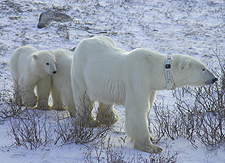For Hudson Bay Polar Bears, The End is Already in Sight
 No polar bears have
No polar bears havebeen more closely studied than Canada’s western Hudson Bay
population.
In recent decades, biologists such as Andrew E. Derocher of the
University of Alberta have compiled an impressive store of data on
everything from the weight of females at denning, to the body mass
of bears of all sexes, to the length of time the bears spend
annually on the shores of Hudson Bay, to the decline of sea ice in
the bay itself.
Now, Derocher, working with Peter K. Molnar and other colleagues
from the University of Alberta, has marshaled that data to forecast
how long it will be before western Hudson Bay’s polar bears
disappear. The calculation is not overly complex, since the health
of polar bears is directly tied to the amount of time they spend on
sea ice hunting seals.
The basic facts are as follows: The region’s polar bears have
been forced to spend an extra week per decade onshore; the bears
have been losing, on average, more than 20 pounds per decade; the
body mass of the bears has been steadily declining; females have
lost 10 percent of their body length; and the population has
dropped from 1,200 to 900 in three decades, with much of the
decline coming in the last 10 years.
Looking at projected sea ice declines, Derocher and his
colleagues estimated in a recent paper in Biological
Conservation that western Hudson Bay’s polar bear population
could well die out in 25 to 30 years.
Indeed, in an interview with Yale Environment 360
senior editor Fen Montaigne, Derocher said that the population -
one of 19 in the Arctic - could be gone within a decade.
All it would take is several straight years of
low sea ice conditions - such as the current year - which could
force the bears onshore for more than five months a year, leading
to a sharp decline in the bears’ physical condition and the
inability of females to gestate cubs.
“One of the things we found was that the changes in this
population could happen very dramatically,” says Derocher.
“And a lot of the change could come within a single year if you
just ended up with an earlier melt of sea ice.”
Source: www.e360.yale.edu
You can return to the main Market News page, or press the Back button on your browser.

